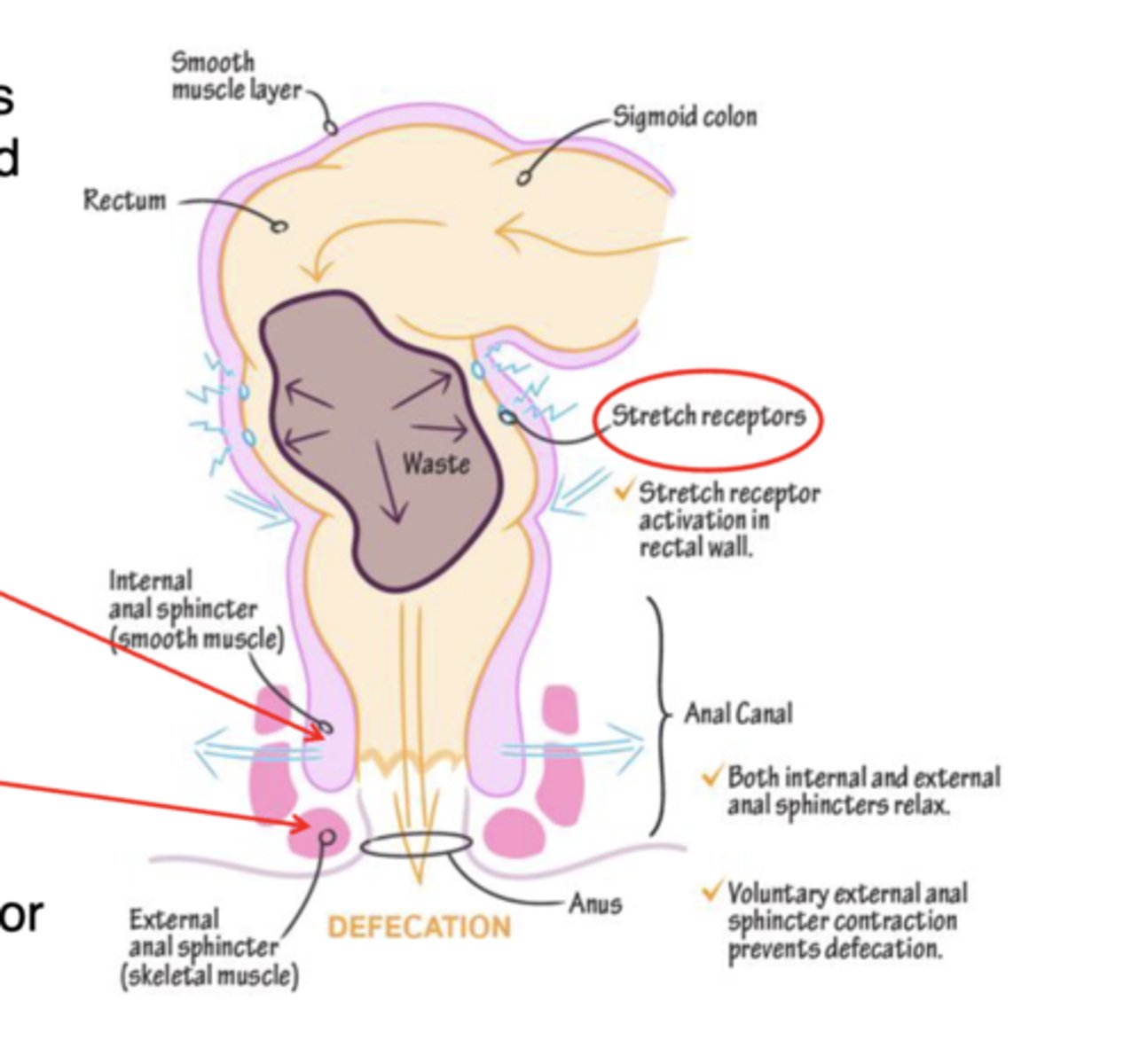Gastrointestinal Physiology: GI Motility
1/65
There's no tags or description
Looks like no tags are added yet.
Name | Mastery | Learn | Test | Matching | Spaced |
|---|
No study sessions yet.
66 Terms
what are sphincters in the GI?
circular muscle thickenings that separate different GI functional areas to assure undirectional movement of digestive material ==> 7 in total
-upper esophageal sphincter (UES)
-lower esophageal sphincter (LES)
-pyloric sphincter
-oddi sphincter
-ileoceal sphincter --> opens & pushes old food into colon whenever new food enters the stomach
-internal anal sphincter
-external anal sphincter
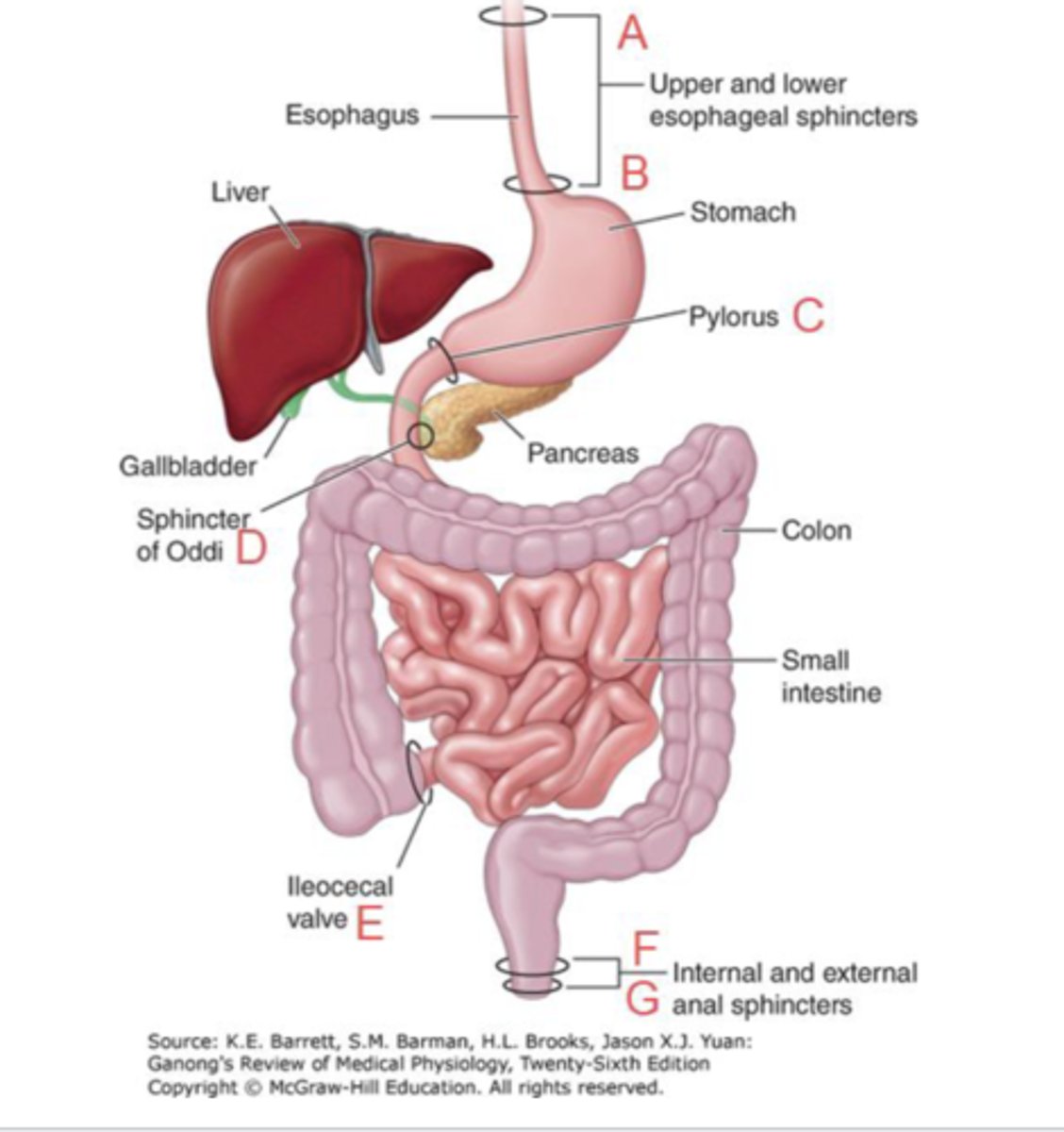
Describe the 2 functional components of swallowing
propulsive functions
food transfer to esophagus
allows food entry into esophagus
transports bolus from pharynx to stomach
allows entry of food into the stomach
protective effects
soft palate & epiglottis protects airway
protects airway from swallowed material
protects airway from gastric reflex
clears material refluxed from the stomach
protects the esophagus from gastric reflux
List the propulsive functions of swallowing
-food transfer to esophagus
-allows food entry into esophagus
-transports bolus from pharynx to stomach
-allows entry of food into the stomach
List the protective functions of swallowing
-soft palate & epiglottis protects airway
-protects airway from swallowed material
-protects airway from gastric reflex
-clears material refluxed from the stomach
-protects the esophagus from gastric reflux
What is deglutition?
swallowing
Describe what happens during the 3 stages of deglutition
buccal phase/ oral transit phase (voluntary)==> tongue moves upwards & backwards against the hard & soft palate to push bolus into oropharynx
pharyngeal phase (involuntary) ==> push bolus thru pharynx & into esophagus via : bolus movement in oropharynx stimulates oropharyngeal receptors --> signals deglutician center in medulla oblongata & lower pons --> stimulate soft palate & uvula to close off nasopharynx + epiglotiss to seal off larynx (prevents bolus from entering respiratory tract) --> upper esophageal sphincter relaxes --> bolus enters esophagus --> upper esophageal sphincter contracts to reduce backflow into pharynx
esophageal stage (involuntary) ==> bolus pushed onward via perstalsis --> lower esophageal sphincter relaxes --> bolus exits esophagus (enters stomach)--> lower esophageal sphincter contracts to reduce backflow
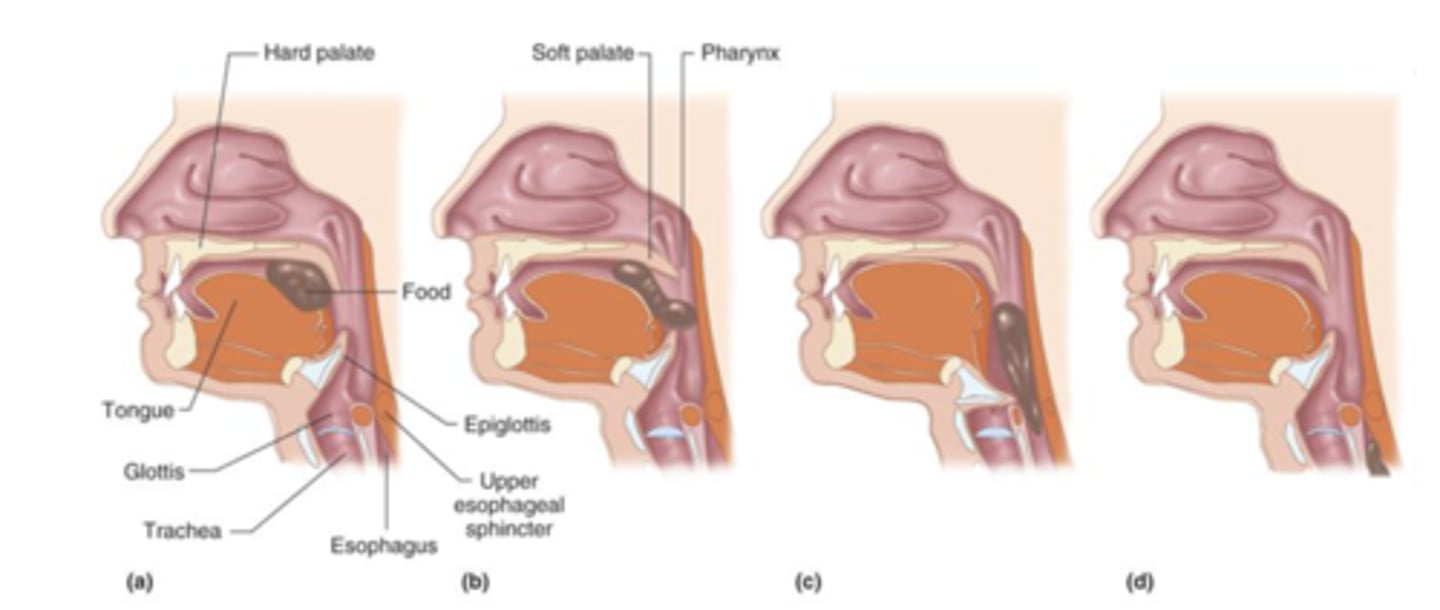
Describe the buccal phase of swallowing
tongue moves upwards & backwards against the hard & soft palate to push bolus into oropharynx
*voluntary
Describe the pharyngeal phase of swallowing
push bolus thru pharynx & into esophagus via : bolus movement in oropharynx stimulates oropharyngeal receptors --> signals deglutician center in medulla oblongata & lower pons --> stimulate soft palate & uvula to close off nasopharynx + epiglotiss to seal off larynx (prevents bolus from entering respiratory tract) --> upper esophageal sphincter relaxes --> bolus enters esophagus --> upper esophageal sphincter contracts to reduce backflow into pharynx
*involuntary
describe the esophageal phase of the esophageal phase of swallowing
bolus pushed onward via perstalsis --> lower esophageal sphincter relaxes --> bolus exits esophagus (enters stomach)--> lower esophageal sphincter contracts to reduce backflow
*involuntary
True or False: The inner muscular layer of the esophagus is made of circular muscle
True
True or False: The outer muscular layer of the esophagus is made of circular muscle.
False ==> outer layer is made of longitudinal muscle
True or False: The upper esophagus is striated skeletal muscle.
True
True or False: The lower esophagus is a striated skeletal muscle.
False ==> lower esophagus contains smooth muscle
True or False: The esophagus is a muscular tube
True
True or False: The esophagus is lined with stratified cuboidal epithelium.
False ==> stratified squamous epithelium
Approximately what spinal level is the upper esophageal sphincter?
C5/6
Approximately what spinal level is the lower esophageal sphincter?
T11
Why is it important to know the approximate spinal locations of esophageal constrictions?
in endoscopy, key landmarks & biopsy locations can be identified by the distance from the incisors
Where are the 3 sites of natural constriction in the esophagus?
-cervical --> circoid cartilage area at level C5/6
-thoracic --> aortic arch level at T4/5
-abdominal --> esophageal hiatus level at T10/11
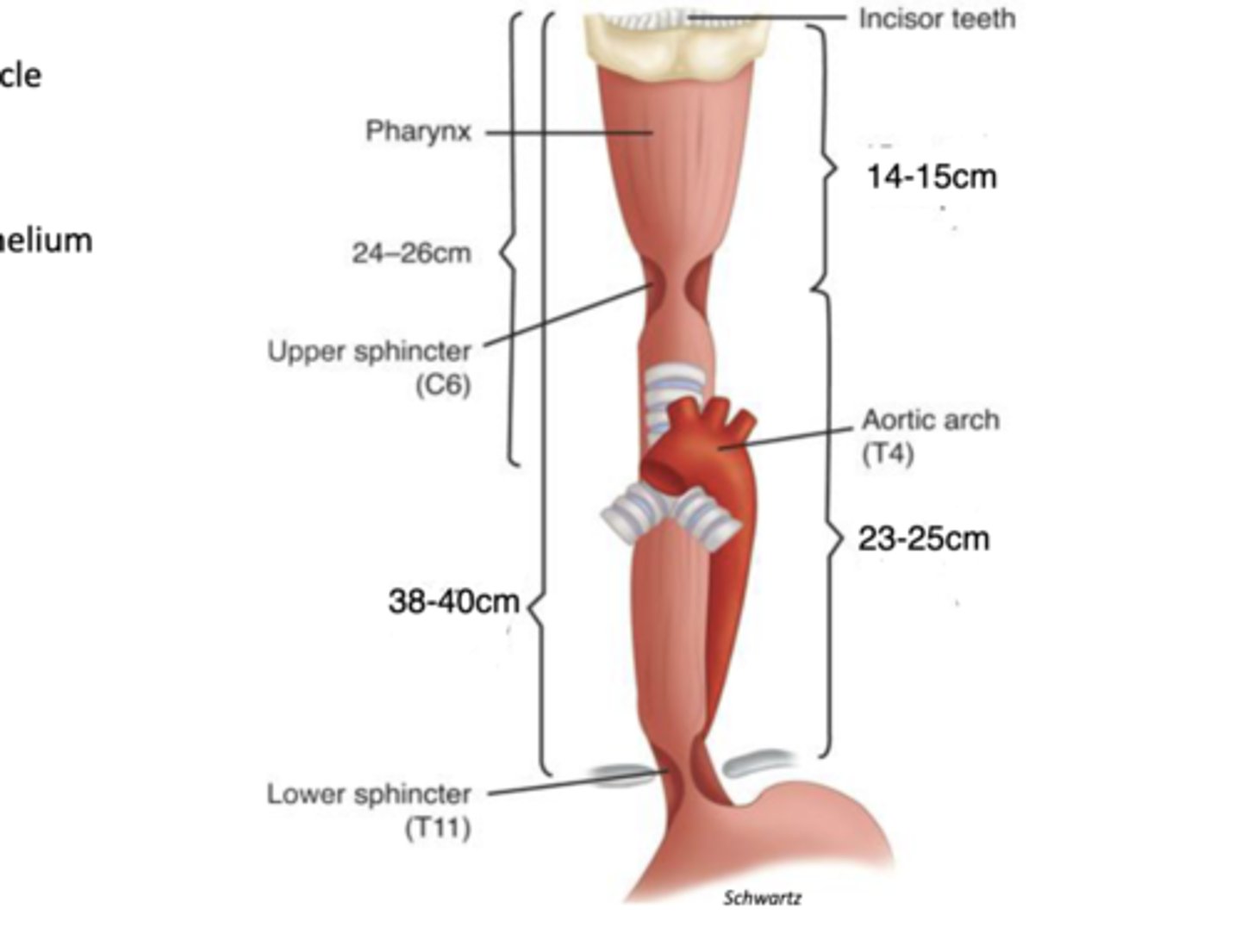
What kind of muscle is the middle 1/3 of the esophagus made of?
both skeletal & smooth muscle
True or False: The GI tract is made up of smooth muscle throughout beginning at the lower esophagus.
True
manometry
measurement of pressures along the esophagus that can be used to diagnose esophageal motility disorders
-upper esophageal sphincter is high pressure at rest to prevent air from entering esophagus
-the esophageal body is low pressure at rest
-the lower esophageal sphincter is high pressure at rest of prevent contents of the stomach from refluxing
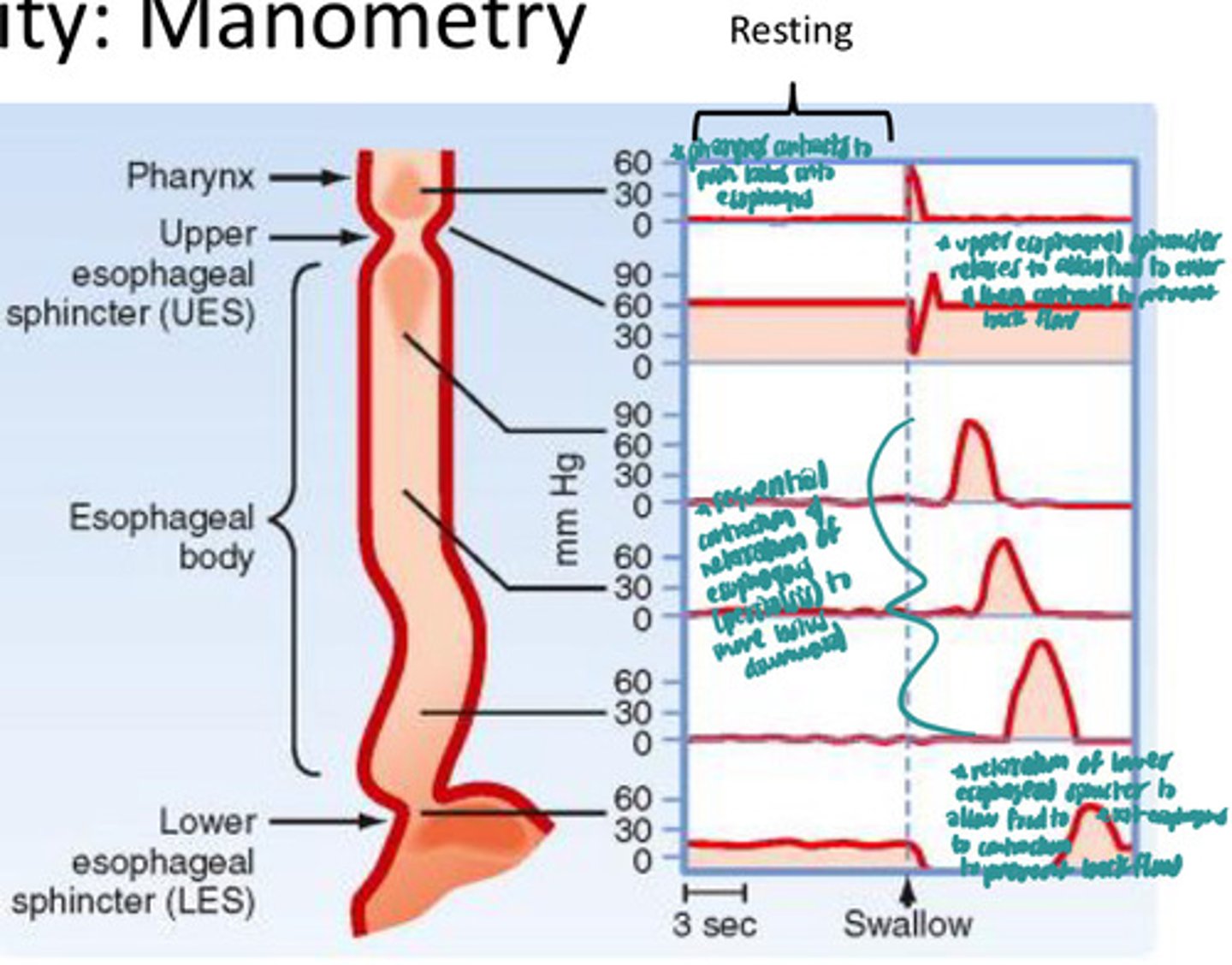
Why is the upper esophageal sphincter high pressure at rest?
to prevent air from entering the esophagus
Why is the esophageal body low pressure at rest?
to allow the bolus to easily progress thru the esophagus
Why is the lower esophageal sphincter high pressure at rest?
to prevent contents of the stomach from refluxing
Describe the sequence of esophageal motility
1.)swallowing==> pharynx constricts --> upper esophageal sphincter opens to allow for bolus to pass --> lower esophageal sphincter & proximal stomach relax
2.) Upper esophageal sphincter constricts
3.) primary peristalsis ==> progressive wave of distension & contraction passes thru the esophageal body
4.) lower esophageal sphincter closes ==> after bolus passes to proximal stomach
5.) secondary peristalsis ==> if all food doesn't clear in primary peristalsis
primary peristalsis
progressive wave of distension & contraction passes thru the esophageal body
secondary peristalsis
second wave of peristalsis is esophagus in case all food wasn' t cleared during primary peristalsis
esophageal peristalsis
sequential contraction of circular muscles of the muscularis propria to occlude the esophageal lumen & push the bolus aborally (away from the mouth)
- sequential contraction of longitudinal muscle mediated by ACh --> shortens the esophagus & increases the cross-sectional diameter to facilitate bolus transport
-nitric oxide sequentially inhibits circular smooth muscle that occurs aborally to the incoming bolus--> relaxation to allow bolus to move down
Why are the longitudinal muscles of the esophagus sequentially contracted during peristalsis?
shortens the esophagus & increases the cross-sectional diameter to facilitate bolus transport
*mediated by ACh
Why are the circular muscles that occur aborally to the bolus in the esophagus sequentially inhibited?
relaxation to allow bolus to move down
*mediated by nitrergics (nitric oxide)
Achalasia
loss of nitrergic neurons (nitric oxide neurons) in distal esophagus, leading to tonic contraction that constricts the lower esophagus + leads to proximal dilation ==> causes difficulty swallowing (aka "Bird's Beak")
*if the LES loses all of its innervation, the tone will increase due to the intrinsic myogenic properties of smooth muscle
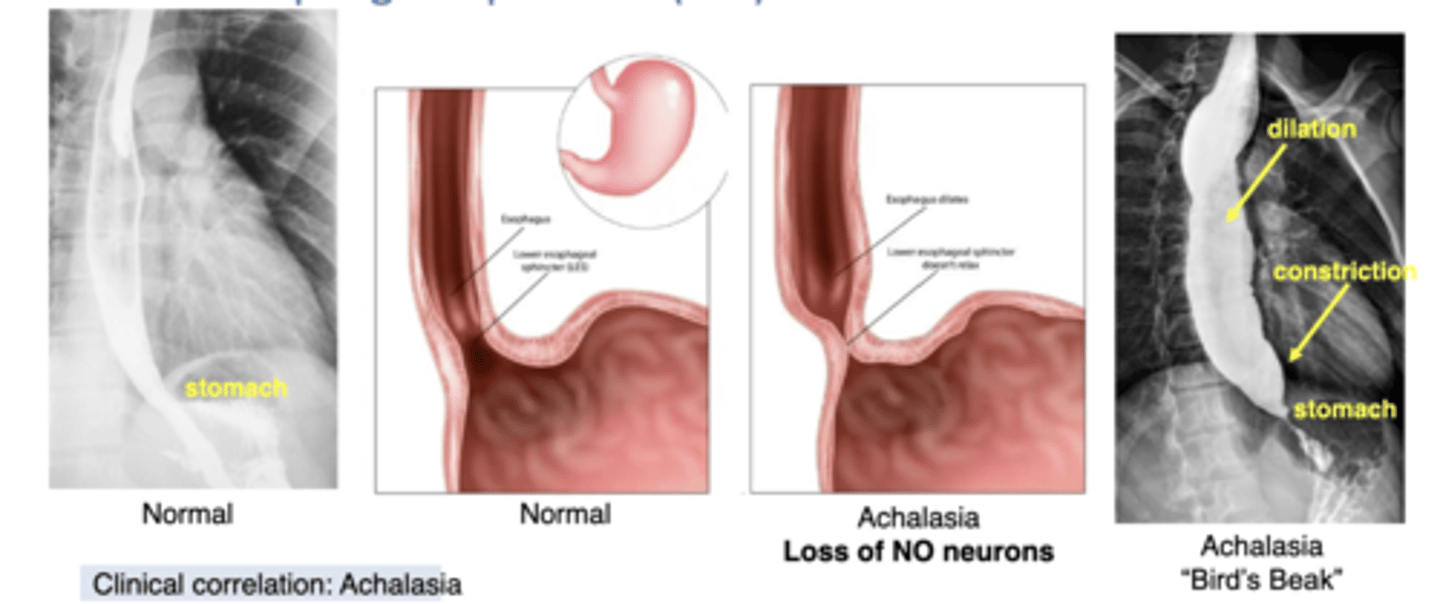
What effect does SNS stimulation have on the enteric nervous system?
inhibition
What effect does the PNS have on the enteric nervous system?
stimulation
*mainly thru the dorsal motor nucleus of the vagus nerve
What constitutes the autonomic nervous system?
-sympathetic NS
-parasympathetic NS
-enteric NS
What is the effect of acetylcholine on the gastrointestinal tract?
excitatory
-stimulates smooth muscle contraction
-increases intestinal secretions
-release enteric hormones
-activate secondary pathway (nitrergic pathway) to dilate blood vessels
What is the effect of norepinephrine on the gastrointestinal tract?
inhibitory of GI secretions, motor activity, & contraction of GI sphincters & blood vessels
*opposite effect of ACh
Where is the enteric nervous system located?
principal components of the enteric nervous system are 2 networks or plexuses of neurons that are embedded in the wall of the digestive tract
-myenteric plexus --> bwtn the longitudinal & circular layers of muscle in tunica muscularis
-submucous plexus --> buried in submucosa
myenteric plexus
component of the enteric NS that exerts control primarily over digestive tract motility
*located bwtn the longitudinal & circular layers of muscle in tunica muscularis
submucous plexus
component of enteric NS that's principal role is in sensing the environment within the lumen, regulating GI blood flow, & controlling epithelial cell fxn for absorption
*buried w/in the submucosa
Why does smooth muscle contract as a single unit?
sheets of single-unit muscle cells contract as a single unit b/c they are electrically linked by gap junctions
True or False: The gap junctions in smooth muscle allow for smooth muscle to be very responsive to distension
True
Smooth muscle does not have t-tubules. Instead they have ______________.
caveolae
Smooth muscle does not have Z-lines (b/c they don't have sacromeres). How are their thin & thick filaments arranged instead?
dense bodies scattered thru the cytoplasm of smooth muscle fibers that act as point of attachment for myofilaments (take place of Z lines in striated muscle)
Smooth muscle doesn't have troponin. Instead they have _______________.
calmodulin
What are the factors that modulate contractile activity of smooth muscle?
-neurotransmitters released by ANS
-hormones
-intrinsic properties that produce spontaneous electrical activity
>distension
>migratory motor complexes (MMC) --> clean up small intestine of food remnants in small intervals thru out the day
-changes in local chemical composition
-stretch
migratory motor complexes (MMC)
intrinsic factors that produce spontaneous electrical activity to clean up small intestine of food remnants in small intervals throughout the day
What are the positive regulators of esophageal contraction?
-ACh
-Substance P (SP)
What are the negative regulators of esophageal contraction?
-nitric oxide (NO)
-vasoactive intestinal peptide (VIP)
Where in the brainstem do the parasympathetic fibers of CNX originate?
dorsal motor nucleus
Where in the brainstem do the somatic fibers of CNX originate?
nucleus ambiguous
What part of the brainstem mediates the contraction of the upper esophagus?
nucleus ambiguous via CNX
What part of the brainstem mediates the contraction of the lower esophagus?
dorsal motor nucleus via CNX
gastroesophageal reflux disease (GERD)
esophageal disease that occurs when stomach acid flows back into the esophagus
*can cause precancerous barrett's esophagus
Barrett's Esophagus
precancerous condition of the esophagus that develops as a result of GERD
esophageal achalasia
motor disorder characterized by a complete loss of contraction & relaxation of muscles used to move contents down the esophagus
paraesophageal hernia
condition where the stomach protrudes thru the diaphragm into the chest alongside the esophagus
esophageal diverticulum
is a pouch that protrudes outward in a weak portion of the esophageal lining
*problems
-blockage/ decreased flow/food gets stuck
-increased pressure/distension = increased chance of rupture
ileocecal valve (ICV)
joining point bwtn the large & small intestines
*2 primary fxns
-control the flow bwtn these 2 areas
-serve as a barrier to prevent the bacteria laden contents of large bowel from contaminating the small intestine
In general, what causes diarrhea or loose stool?
excess motility of large intestine--> less fluid absorption --> diarrhea or loose stool
In general, what causes constipation?
poor motility of large intestine --> greater absorption of fluid
--> formation of hard stool in transverse colon
What is responsible for the primary movements seen in the large intestine?
-haustral contractions
-mass movements
*occurs mostly in ascending & transverse colon
Where in large intestine are primary movements mostly seen?
-ascending colon
-transverse colon
haustral contractions
slow contractions that occur about every 30 mins & last approx 1 min stimulated by stretch when food remnants fill the haustra
mass movements
long, slow moving, powerful contractions that move over the colon 3 or 4 times per day, typically after meals
*gastrocolic reflex that accompanies gastroileal reflex stimulated by gastrin release when the stomach receives food
How is the defecation reflex initiated?
feces forced into the rectum by mass movements--> stretch the rectal wall --> initiate defecation reflex -->internal anal sphincter relaxes --> voluntary motor neurons are inhibited (if convenient to go boo boo) --> external anal sphincter relaxes --> feces passes
